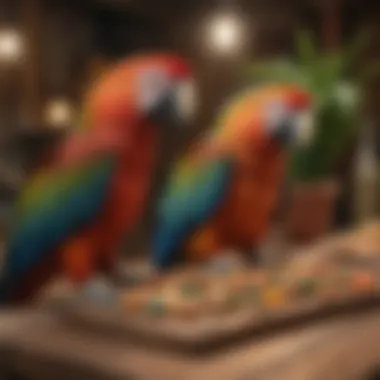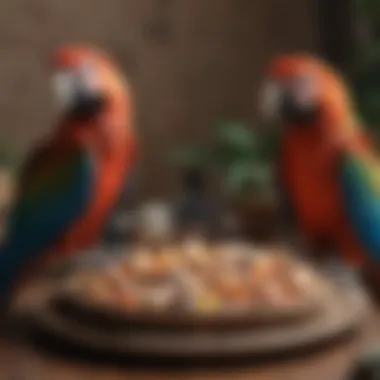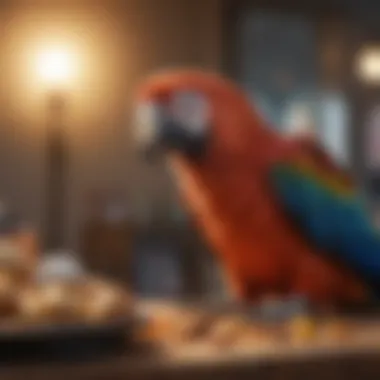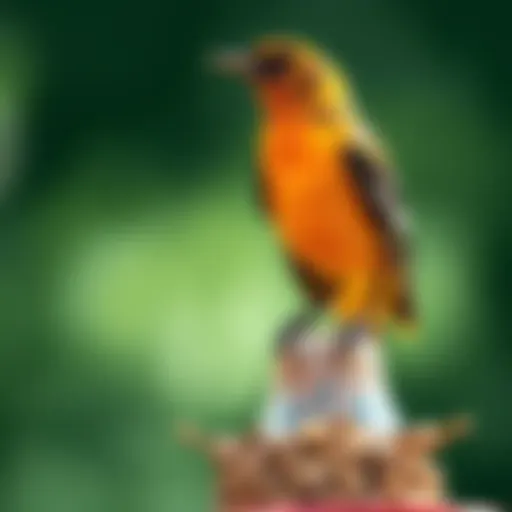The Ultimate Guide to Macaw Treats for Wellbeing


Intro
Understanding the world of macaws is like diving into a vibrant canvas painted with hues of personality, intelligence, and sheer joy. Macaws, with their majestic feathers and playful behavior, hold a special place in the hearts of avian enthusiasts. However, keeping these beautiful creatures happy and healthy extends beyond just providing a spacious cage and fresh water. The right treats play a pivotal role in their overall well-being. In this guide, we will explore a variety of nutritious options and their significance in training, bonding, and complimenting the natural diet of these extraordinary birds.
Avian Care Basics
Importance of Proper Nutrition
When it comes to macaws, nutrition is the cornerstone of their health. These birds require a balanced diet rich in vitamins, minerals, and essential fatty acids. Treats, while often viewed as a luxury, can serve as a source of important nutrients. It's essential to select those that not only satisfy their taste buds but also align with their dietary needs.
Offering raw nuts, seeds, or even pieces of fruits like bananas and apples can cater to their craving while packing a nutritional punch. However, moderation is key; too many treats can lead to obesity, which brings a host of health issues.
Understanding Bird Species and Their Needs
Different macaw species come with distinct dietary needs. For instance, the Blue-and-yellow Macaw has different preferences compared to the Scarlet Macaw. Knowing these differences can guide treat selection.
- Blue-and-yellow Macaws: Enjoy various fruits and vegetables, particularly those high in vitamin A.
- Scarlet Macaws: Have a penchant for high-fat nuts, but should only have them in limited quantities.
Basics of Birds Habitat Setup
A well-structured habitat is crucial for the comfort and happiness of your macaw. The cage should be spacious enough for them to stretch their wings and should include perches of varying diameters for foot health. Incorporating toys that stimulate their minds contributes to emotional health. Treats can be hidden within these toys, turning them into an engaging activity for your bird.
Grooming and Hygiene Tips
Regular grooming is a vital aspect of macaw care. Their feathers should be clean and free from debris. Bath time, whether in a shallow dish or misting with water, can be an enjoyable treat for them. Maintain their nails by providing suitable perches which help to naturally wear them down. By establishing a proper hygiene routine, the risk of health issues can diminish.
Interacting with Your Pet Bird
Building Trust and Connection
Trust doesn’t come overnight. Establishing a bond with a macaw requires patience and consistency. Start with gentle gentle movements and avoid sudden noises. Treats can be an excellent way to reinforce positive interactions. Offering them a favorite snack on your hand fosters trust vastly.
Training Techniques and Tips
Training a macaw can be a rewarding experience, and treats serve as a key motivator. Clicker training is one effective method, where the act of performing a desired action is followed by immediate rewarding with a treat. Positive reinforcement advocates that desired behaviors are repeated as a result of enjoyable rewards.
Fun Activities for Bird Owners and Their Birds
Birds, like humans, flourish when engaged in stimulating activities. Here are a few ideas:
- Treasure Hunts: Hide treats around the cage or play area for them to discover.
- Target Training: Use a stick to train them to touch specific objects, rewarding them when they succeed.
Recognizing Bird Cues and Behaviors
Understanding your macaw's body language can deepen your connection. Signs of contentment often include preening and gentle chirps, while infrequent movement and heavy flapping might indicate stress. Learning these cues helps to adapt interactions accordingly.
Emotional Well-Being of Birds
The Role of Play and Socialization
Macaws are social creatures that thrive on companionship. Engaging in play not only strengthens your bond but also bolsters their mental health. Interactive toys are a great way to foster cognitive development.
Enhancing Birds' Emotional Health
Creating an enriched environment with various toys, climbing structures, and treat-dispensing opportunities gives macaws more opportunities for exploration and play. Just like children, they benefit from variety and novelty.
Assessing Bird Stress and Remedies
Stress in macaws can manifest in changes in eating habits or excessive vocalization. Creating a routine can offer a sense of stability. Ensuring a calm environment will also help mitigate stress. If you notice significant changes, it may be wise to consult a vet.
Building Strong Human-Bird Bonds
Consistent interaction and love is fundamental for strong bonds. Scheduled playtimes should be a ritual, allowing your macaw to feel secure and cared for. This bond will make your training experience smoother, and help them in their happiness.
Bird Health and Safety
Common Health Issues and Prevention
Macaws can face several health issues, particularly obesity, feather plucking, and respiratory issues. Ensuring a balanced diet and regular activity helps prevent these problems.
Routine Veterinary Care
Regular vet visits are essential for macaws to monitor their health. Establishing a relationship with an avian vet ensures you have access to the best advice whenever needed.
Environmental Hazards to Avoid
Be mindful of in home plants that may be toxic to birds, such as philodendron and avocado. Similarly, second-hand smoke can severely impair their health.
Signs of Illness or Distress
Take note of unusual behavior such as lethargy, lack of appetite, or changes in vocalization. Early detection can be pivotal in ensuring their well-being.
Fun Facts and Quirky Insights
Unique Traits of Popular Bird Species
Macaws are known for their impressive vocal abilities. Some can mimic human speech and often have quite an extensive vocabulary.
Historical and Cultural Significance of Birds


Throughout history, birds have been symbols of freedom, wisdom, and even messengers in various cultures. Macaws, owing to their vibrant colors, have often been featured in art and mythology.
Famous Bird Owners and Their Stories
Many celebrities have shared their lives with macaws. For instance, the iconic artist John Lennon had a strong bond with his macaw, offering a glimpse into the possible unique relationships between humans and birds.
This guide emphasizes that treating your macaw well is not just about what goes into their beak, but about forging relationships, creating an enriching habitat, and nurturing their emotional health. These aspects combined can lead to a happy, thriving, and healthy macaw.
Understanding Macaw Nutrition
Understanding macaw nutrition is crucial for maintaining the health and happiness of these remarkable birds. Without proper nutritional knowledge, one might inadvertently provide an unbalanced diet, which could lead to serious health issues. As macaws are social and intelligent creatures, their dietary needs go beyond just satisfying hunger; they require a carefully curated balance of nutrients to thrive both physically and mentally. The right nutritional components foster a strong immune system, vibrant feathers, and overall vitality. With this guide, we'll delve into the essentials of macaw nutrition, touching on what makes their diet unique and why every bit of it matters.
Essential Nutritional Components
Macronutrients
Macronutrients—proteins, fats, and carbohydrates—serve as the primary building blocks of a macaw's diet. Each of these elements plays a distinct role. For instance, protein is vital for growth, feather development, and overall body maintenance. Fats are essential not just for energy; they also support metabolic functions and hormone production. Carbohydrates provide immediate energy, essential for an active birds, especially those that fly.
When looking at macronutrients, it’s important to keep in mind that not all sources are created equal. High-quality, natural food sources like certain seeds, legumes, and nuts often provide a more bioavailable form of nutrients compared to processed options.
Vitamins and Minerals
Vitamins and minerals are the unsung heroes in the nutrition story. These micronutrients assist in numerous bodily functions, such as metabolism and neurological activity. Specifically, vitamins A, D, and E are among the most beneficial for macaws, contributing to vision health, skin health, and overall cellular function. Additionally, minerals like calcium and phosphorus are critical for strong bones and reproductive health.
Using good dietary practices will help ensure a balanced intake of these important vitamins and minerals. A colorful diet that includes various fruits and vegetables not only adds visual appeal but is also a strategy for acquiring a broad spectrum of nutrients.
Water Requirements
Water can often be overlooked but is just as essential as food. Macaws require fresh and clean drinking water daily. Hydration impacts digestion, nutrient absorption, and temperature regulation. Birds aren't like humans; they cannot over-consume water and will drink instinctively when they need it. The key here is to ensure that they have access to clean water at all times, especially when it's hot out or after they've eaten dry food.
- Regularly checking the water supply can prevent possible dehydration and ensures your macaw remains vibrant and healthy.
Identifying Nutritional Deficiencies
Symptoms of Deficiencies
Identifying nutritional deficiencies early can be lifesaving. Symptoms can vary significantly, with some presenting as external signs like feather plucking, dull plumage, or lethargy. Others might be less obvious, disguising themselves as behavioral changes, like increased irritability or aggression. A keen observer can spot these signs, which serves as a prompt to re-evaluate the diet.
Key takeaway: Recognizing these symptoms early on can lead to timely interventions.
Common Nutritional Gaps
Certain gaps in nutrition can sneak into a macaw's diet. Often commercial pellets may lack diversity, leading to deficiencies in essential vitamins and minerals. A good practice for new and seasoned bird owners alike is to keep a log of what foods are consumed daily and assess if they meet the recommended dietary guidelines.
Relying solely on one type of food or treat brings the risk of imbalances. The beauty of caring for macaws lies in the variety you can offer. Mixing various healthy options can effectively fill these gaps and help keep your feathered friend thriving.
Role of Treats in Macaw Care
Treats play a pivotal role in macaw care, going beyond mere indulgences. They are a powerful tool that can enhance well-being and happiness in these vibrant birds. Engaging with macaws through treats not only supplements their diet but also builds relationships and builds trust with their owners. Understanding how to effectively incorporate treats into macaw care can elevate everyday interactions into meaningful bonding experiences.
Enhancing Bonding and Trust
Interaction During Treat Time
The moments spent interacting with a macaw during treat time are golden opportunities for connection. When a bird eagerly approaches for a favorite snack, it fosters trust and confidence. This is because macaws are social creatures that thrive on interaction. The act of offering a treat can transform a mundane daily routine into a time of bonding.
A key characteristic of this interaction is the way it allows for personal space and choice. The owner can offer the treat in a relaxed manner, allowing the macaw to feel safe and respected. Consequently, trust is established, which is fundamental for a healthy relationship between human and bird.
The unique feature here is the direct response from the bird—whether they take the treat eagerly or hesitate. This interaction gives the owner insights into their macaw's mood and well-being. On the flip side, over-reliance on treats for bonding could lead to behavioral dependency, making it crucial to balance treat time with other types of interaction.
Creating Positive Associations
Creating positive associations with treats can significantly impact a macaw's disposition. When good behavior is rewarded with a favorite snack, birds quickly learn to link that behavior with positive reinforcement. This aspect of training is not only beneficial for the macaw but also for the owner, as it simplifies communication between them.
A primary characteristic of this method is its effectiveness in altering behavior. For example, a macaw that exhibits shy behavior might come out of its shell faster when rewarded for socializing with treats. It's a powerful shift that can lead to a happier bird.
The unique aspect of fostering positive associations is the gradual building of a more robust relationship. However, owners should be cautious not to overuse certain treats which might lead to the bird becoming selective or demanding—an understandable behavior rooted in their natural instincts.
Incorporating Treats in Training
Reinforcement Techniques
Incorporating treats in reinforcement training is an impactful approach to shaping a macaw's behavior. This technique relies on the principle of conditioning, where desired behaviors are reinforced through delicious incentives. The effectiveness of this technique lies in its immediacy; offering a treat right after the desired action solidifies the connection in the bird's mind.
One notable characteristic is the versatility that comes with different types of treats. Insights shared among owners often highlight that varied treat options—ranging from fruits to nuts—can keep the bird intrigued and engaged in training. This diversity can inspire a more responsive learning environment rather than monotonous sessions.
Yet, it’s important that owners remain mindful of how many treats are given. If an owner uses treats excessively during sessions, the bird may expect rewards for even the simplest of commands, ultimately undermining the training process.
Timing and Frequency of Treats
Timing and frequency of treats is a significant element in optimizing their effectiveness as training aids. Knowing when to offer treats can mean the difference between success and frustration in training sessions.
A key characteristic of this concept is the balance required to maintain a macaw’s health while also keeping them motivated. Regularly scheduled treat times can boost excitement, while random rewards can prompt a stronger response during training. Moreover, the use of treats to punctuate specific achievements can reinforce positive behavior.
One unique feature of timing treats involves observation. Owners need to pay attention to how their birds respond to different frequencies. If treats are given too frequently, the bird may instead lose interest, while too few may lead to frustration. Essentially, a well-timed treat system can greatly impact the training journey for both the owner and the macaw.
Studies show that incorporating treats as a part of positive reinforcement contributes to better overall behavior and happiness in macaws. Taking note of your bird's dietary needs and preferences can play an essential role in this process.


The careful consideration of integrating treats into care routines can’t be overstated. The nuances of behavior shaped by treat interactions lay the groundwork for a long-lasting bond, built on trust and understanding.
Types of Acceptable Treats for Macaws
When it comes to caring for macaws, understanding the various types of treats is crucial. Treats can serve multiple purposes: they can enhance bonding, support training, and contribute positively to a macaw's nutrition. They are not just a reward but an integral part of enriching your bird's life. Selecting the right treats ensures that they provide benefits without compromising health.
Healthy Fruits and Vegetables
Fruits Rich in Nutrients
Fruits can add a burst of color and flavor to a macaw's diet, while also offering numerous nutrients. For instance, mangoes, papayas, and berries are high in vitamins, particularly vitamin C, which is vital for your bird's immune system. These fruits are not only tasty but also provide hydration, which is essential in a macaw's overall well-being.
A key characteristic of nutrient-rich fruits is their natural sugars and fibers, making them a diifferent choice compared to processed snacks. However, while these fruits are nutritious, moderation is key.
- Advantages
- Disadvantages
- High vitamin content
- Naturally hydrating
- Encourages foraging behavior
- Can be high in sugars, leading to obesity if overfed
Vegetable Options for Macaws
Vegetables also play a significant role in a balanced diet for macaws. Dark leafy greens like kale and collard greens provide essential minerals and are often favored by different types of birds.
A unique feature of vegetables is their fiber content, which supports digestive health in macaws. Incorporating a variety of vegetables not only enhances nutrition but also keeps meals interesting for your bird.
- Advantages
- Disadvantages
- High in fiber and low in calories
- Offers a range of vitamins and minerals
- Supports digestive health
- Some macaws may be picky, creating challenges in maintaining balanced nutrition
Seeds and Nuts Considerations
Nutritional Value of Seeds
Seeds can be a rich source of essential fatty acids, protein, and fiber. For instance, pumpkin and sunflower seeds are often favorites among macaws. They provide necessary energy but should be given thoughtfully due to their high fat content.
Nutritional value varies across types, and it's important to consider that not all seeds are created equal. Opting for unsalted and raw seeds can help maintain health while providing tasty options.
- Advantages
- Disadvantages
- Good source of healthy fats
- Energetic boosters for active birds
- Overconsumption can lead to obesity
Choosing Safe Nut Varieties
Nuts can also present a delightful and nutritious snack. Almonds, walnuts, and pistachios provide healthy proteins and are typically safe for macaws. A key factor when selecting nuts is to ensure they are organic and free of additives that can be harmful to your bird.
- Advantages
- Disadvantages
- Packed with nutrients and healthy fats
- Versatile use in treats and enrichment activities
- High in caloric content; should be given sparingly
Commercial Treats: Pros and Cons
Evaluating Quality Ingredients
Many commercial treats are available and sometimes make life easier for owners. However, reading the label is essential. A treat with a list of ingredients filled with chemicals and preservatives can cause more harm than good. Look for options with natural ingredients.
- Advantages
- Disadvantages
- Convenient and easy to find
- Often specially formulated for bird health
- May contain unhealthy additives
Potential Risks and Benefits
While commercial treats can be beneficial in some aspects, potential drawbacks also exist. For example, many processed treats may be high in sugars and low in beneficial nutrients. They can lead to poor habits over time if not carefully regulated.
A careful examination of the nutritional info can help inform choices. Knowledge is power, especially when it comes to your macaw's health.
- Advantages
- Disadvantages
- Can simplify treats in training
- Often made for specific dietary needs
- Risk of unhealthy habits if over-relied on
Preparing Homemade Treats
When it comes to ensuring a happy and healthy life for macaws, preparing homemade treats stands tall as a vital part of their diet. Not only do these treats allow for control over the ingredients, which is crucial for your bird’s health, but they also provide opportunities for creativity in the kitchen. Homemade treats can be tailored to meet the specific tastes and nutritional needs of your macaw, reinforcing good habits both in diet and in bonding with their owners. Making treats at home can save money, too, while giving you peace of mind knowing exactly what your bird is munching on.
Recipes for Nutrient-Rich Treats
Fruit and Nut Mixes
When we talk about nutrient-rich treats, fruit and nut mixes shine brightly. They combine the sweetness of fruits with the hearty crunch of nuts, delivering a double dose of nutrition that your macaw will love. The variety offered by these mixes not only caters to their palate but also keeps boredom at bay. These mixes are often loaded with essential vitamins, minerals, and healthy fats, promoting not just good health but also vibrant feathers and energy levels.


Packing a punch with vitamins, fruits like papaya, mango, and berries provide lots of antioxidants. Coupled with nuts such as walnuts or almonds, which offer omega-3s and protein, this treat is beneficial and popular among macaw owners. Don't forget, moderation is key; while nuts provide essential fats, some varieties can be quite high in calories. So, balancing ingredient ratios is important to ensure well-rounded nutrition without going overboard.
A well-prepared fruit and nut mix can strengthen your connection with your macaw, making treat time a cherished moment.
Vegetable Medleys
Next up, we have vegetable medleys. These colorful combinations not only look appealing but they are a powerhouse of nutrients. Macaws, being naturally curious, often enjoy the different textures and flavors that come from various vegetables. Leafy greens like kale and spinach are excellent choices, rich in iron and calcium. Pair these with crunchy carrots or bell peppers for a bright, tasty treat that supports good vision and strong bones.
Vegetable medleys are generally low in calories but packed with fiber, which aids in digestion and keeps your macaw feeling full. The fresh and diverse nature of veggies makes it a great option for keeping your feathered friend engaged. A common challenge is that some macaws can be picky eaters, so it's beneficial to experiment with different combinations until you find the mix that tantalizes their taste buds.
Safety Precautions in Homemade Treats
Avoiding Toxic Ingredients
Safety first! When preparing homemade treats, avoiding toxic ingredients is non-negotiable. Certain foods like chocolate, avocado, and onion can be highly harmful to macaws. Understanding what’s safe is crucial not just for crafting delicious snacks but for the overall wellbeing of your bird. Conducting thorough research before whipping up a batch is essential.
It's also wise to avoid using excessive salt, sugar, or artificial additives that could pose risks. Sticking to natural ingredients ensures that every treat is as nourishing as it is enjoyable. Being knowledgeable about the potential dangers helps create a safe feeding environment for your macaw. Discussing with a vet on dietary options can be beneficial as well, offering expert guidance.
Storage and Freshness Tips
Once treats are made, the next step is figuring out how to keep them fresh. Proper storage can extend the life of your homemade goodies, making sure your macaws get the best. For instance, using airtight containers in a cool, dry place helps maintain the freshness of both fruit and nut mixes as well as vegetable medleys.
Labeling containers with dates helps track their age—freshness is vital. Keeping an eye on how the treats smell and look can also indicate when they’re past their prime. While it may be tempting to prepare large batches, it’s wise to make smaller amounts that can be consumed quickly. This strategy prevents spoilage and the risk of your macaw getting ill from stale treats.
Monitoring Treat Consumption
Keeping an eye on how much your macaw indulges in treats isn’t just a matter of spoiled birds. It’s crucial for their overall health and happiness. Treats, while a delightful addition to their diet, can pose risks if consumed in excess. Striking a balance ensures that your feathered friend remains vibrant and energetic.
Establishing Healthy Treat Limits
Caloric Intake vs. Treats
One of the most critical conversations revolves around caloric intake. Macaws have specific energy requirements that can easily be overshadowed by an overabundance of treats. As they say, "too much of a good thing can be a bad thing." Treating your macaw shouldn’t derail their nutrition. Ideally, treats shouldn't make up more than 10% of their daily calories. This principle serves as a guidepost for macaw parents to strike a healthy balance in their diets, ensuring they mainly consume their essential foods.
When integrating treats, it is important to evaluate the caloric density of the foods you offer. For example, nuts are calorie-rich and can quickly lead to weight gain if overfed. A unique aspect of monitoring caloric intake is adjusting based on your macaw's activity level, age, and general health. It allows you to tailor your treat strategy to your specific bird’s needs.
Adjusting Diet for Treats
Adjusting the core diet to accommodate treats is another essential factor. It's not just about controlling how many snacks they get but also about ensuring that the overall diet is well-rounded. Suppose you're introducing more treats into your macaw's routine. In that case, you need to be mindful about cutting back on other high-caloric foods to maintain a suitable balance.
This method underscores an essential characteristic of designing a healthy dietary framework for your macaw: flexibility. Each bird is unique, and understanding what works for your specific macaw is vital. Not only does this approach promote a healthier weight for your bird, but it also helps ensure that their nutritional needs are met. Monitoring becomes a vital tool in your arsenal when adapting their diet over time.
Observing Behavioral Changes
When it comes to the link between treats and behavior, subtle shifts can speak volumes. Treats can enhance or impede the way your macaw behaves, so paying attention is critical.
Linking Treats to Behavior
Every treat serves as a form of communication between you and your macaw. If treats are used effectively, they can train your bird to perform tricks, respond to calls, or even to socialize better with humans and other pets. When you offer a favorite snack after a desired behavior, it reinforces that action. Over time, you'll notice patterns. For instance, your macaw might start to output sounds or attempt to do tricks they’ve seen you reward them for.
However, it’s also vital to recognize potential pitfalls, such as a bird becoming more reliant on treats for motivation. Your feathered friend should not solely engage in interaction because of food. Understanding this relationship allows for a balanced training approach.
Identifying Potential Issues
Sometimes, the consumption of treats might unveil underlying issues. If a normally playful macaw seems lethargic or shows sudden disinterest in food, investigating whether treat consumption has changed is a wise move. Linking changes in behavior to treat habits might help you catch health problems before they escalate.
Monitoring treats is no small task; it’s part of a broader effort to observe and understand your bird’s daily habits. Keeping tabs on their intake not only benefits their physical health but also underlying psychological factors too. This holistic approach can result in a more enriching life for your macaw, filled with joyful interactions and a strong bond with their human companions.
"A healthy macaw is a happy macaw," which makes monitoring treat intake all the more essential.
Closure and Best Practices
When it comes to caring for macaws, understanding treat selection and incorporating appropriate practices are crucial. The information outlined in this guide isn't merely for whimsical indulgence; it plays a fundamental role in establishing a solid foundation for both the health and happiness of these colorful birds.
In essence, treats should not be an afterthought but an integrated part of your macaw's daily regimen. Striking a balance between nutrition and enjoyment can deepen your bond, enhance training efforts, and ultimately contribute to a thriving avian companion.
Summary of Key Points
Nutritional Importance
Nutrition lies at the heart of a macaw's wellbeing. A diet rich in variety and essential nutrients is not just beneficial but vital for their overall health. Macaws require a complex blend of macronutrients and micronutrients to function optimally. By understanding and implementing appropriate dietary choices, bird owners can support everything from proper feathering to longevity.
Unique in their nutritional needs, macaws tend to thrive on a diverse palette, incorporating seeds, nuts, fruits, and vegetables. This diversity not only caters to their physical needs but also enriches their sensory experiences. However, it’s essential to remain attuned to imbalance — too many treats, especially those rich in fat or sugar, can lead to obesity and health complications.
Treat Selection and Preparation
Selecting treats for macaws is an art that combines careful consideration with creativity. When preparing or purchasing treats, owners should focus on their nutritional value and safety. Natural options such as fresh fruits or homemade vegetable snacks offer an avenue to cater to your macaw's preferences while ensuring that they receive vital nutrients.
The preparation of treats can become a shared experience, engaging both the owner and the bird. Be mindful, however. Homemade treats must avoid toxic ingredients such as avocado or chocolate, which can be extremely detrimental. The goal here is not to just appease but to provide the very best.
Long-Term Considerations for Macaw Treats
Adapting Treats Over Time
As macaws age, their dietary requirements may also shift. New health conditions, changing metabolic rates, or lifestyle adjustments necessitate that owners reassess treat options periodically. This adaptation is crucial not merely for maintaining a healthy weight but also for ensuring that dietary preferences remain enjoyable and engaging.
Change can be beneficial if you make it a practice to gradually introduce new treats, ensuring that your bird's taste buds remain stimulated. The unique feature of adaptation is that it keeps the bond between you and your macaw fresh, making treat time something both of you look forward to rather than simply a routine.
Building a Balanced Diet
A balanced diet is more than just proper nutrition; it encompasses a holistic approach to health and wellbeing. Ensuring that treats complement balanced meals is key to achieving optimal health for your macaw. Owners should aim for variety in their selections, incorporating items that provide different vitamins, minerals, and fats.
This comprehensive view not only addresses short-term satisfaction but reflects a commitment to long-term health. A balanced diet, inclusive of various treat options, aids in developing strong bones, vibrant plumage, and enhances overall vitality.
Remember, treats should never be the mainstay of your macaw's diet — rather, they serve as an exciting addition meant to enhance their life.















